Hospitality Consumer Behavior Analysis and Decision Making
VerifiedAdded on 2023/01/19
|13
|3431
|98
Report
AI Summary
This report delves into the intricacies of consumer behavior within the hospitality industry, focusing on Whitbread as a case study. It examines the consumer decision-making process, including need recognition, information gathering, evaluation of alternatives, purchase, and post-purchase evaluation. The report explores the importance of mapping the path to purchase for marketers, highlighting the stages of pre-purchase, purchase, receive, and post-purchase. It differentiates between B2B and B2C decision-making processes within the hospitality context, analyzing market research approaches and methods. Furthermore, it evaluates how marketers influence various stages of consumer decision-making, considering factors such as heuristics, marketing mix elements, and new technologies. The report provides insights into how consumer perceptions and behaviors impact the success of hospitality businesses and offers strategies for effective marketing within the industry.
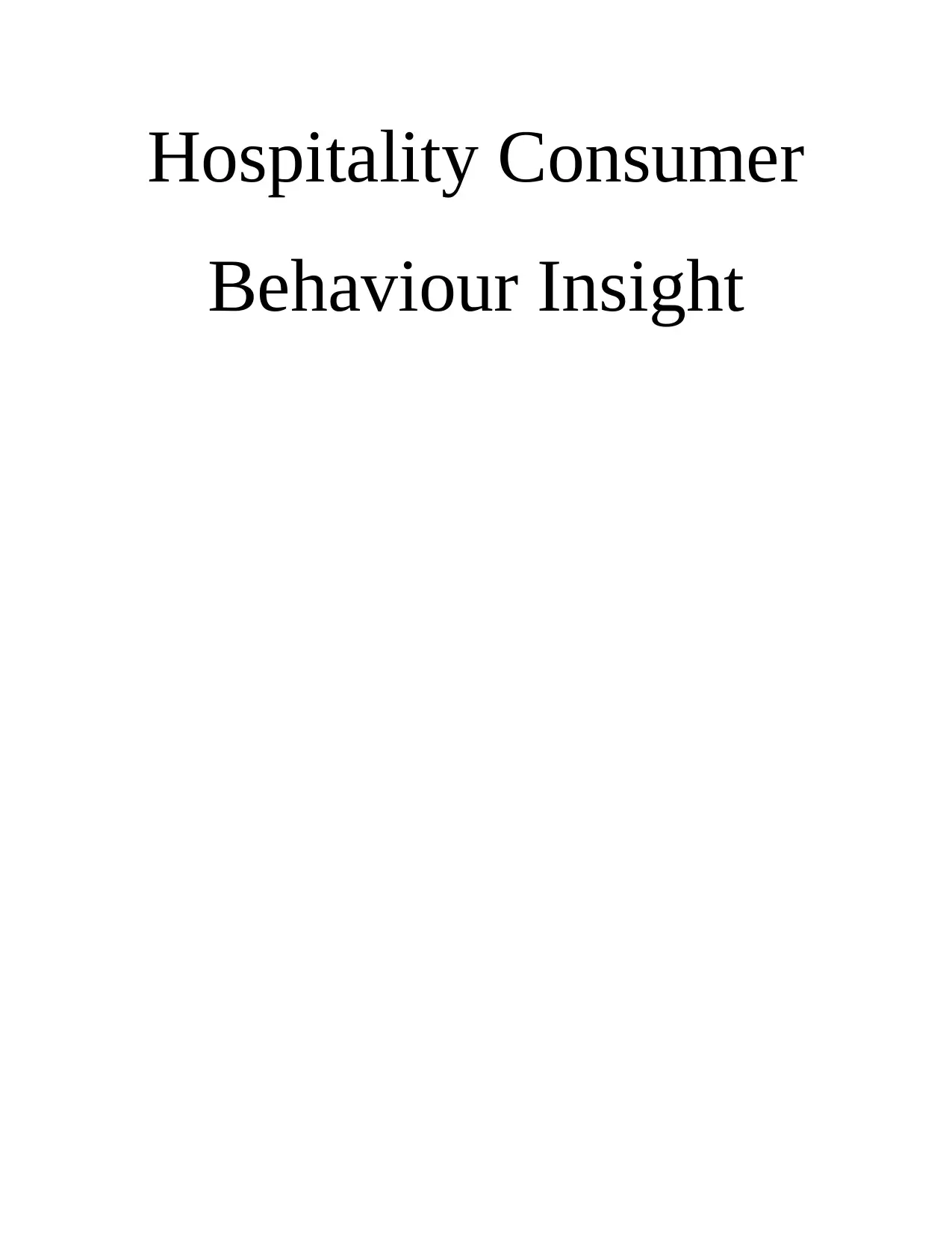
Hospitality Consumer
Behaviour Insight
Behaviour Insight
Paraphrase This Document
Need a fresh take? Get an instant paraphrase of this document with our AI Paraphraser
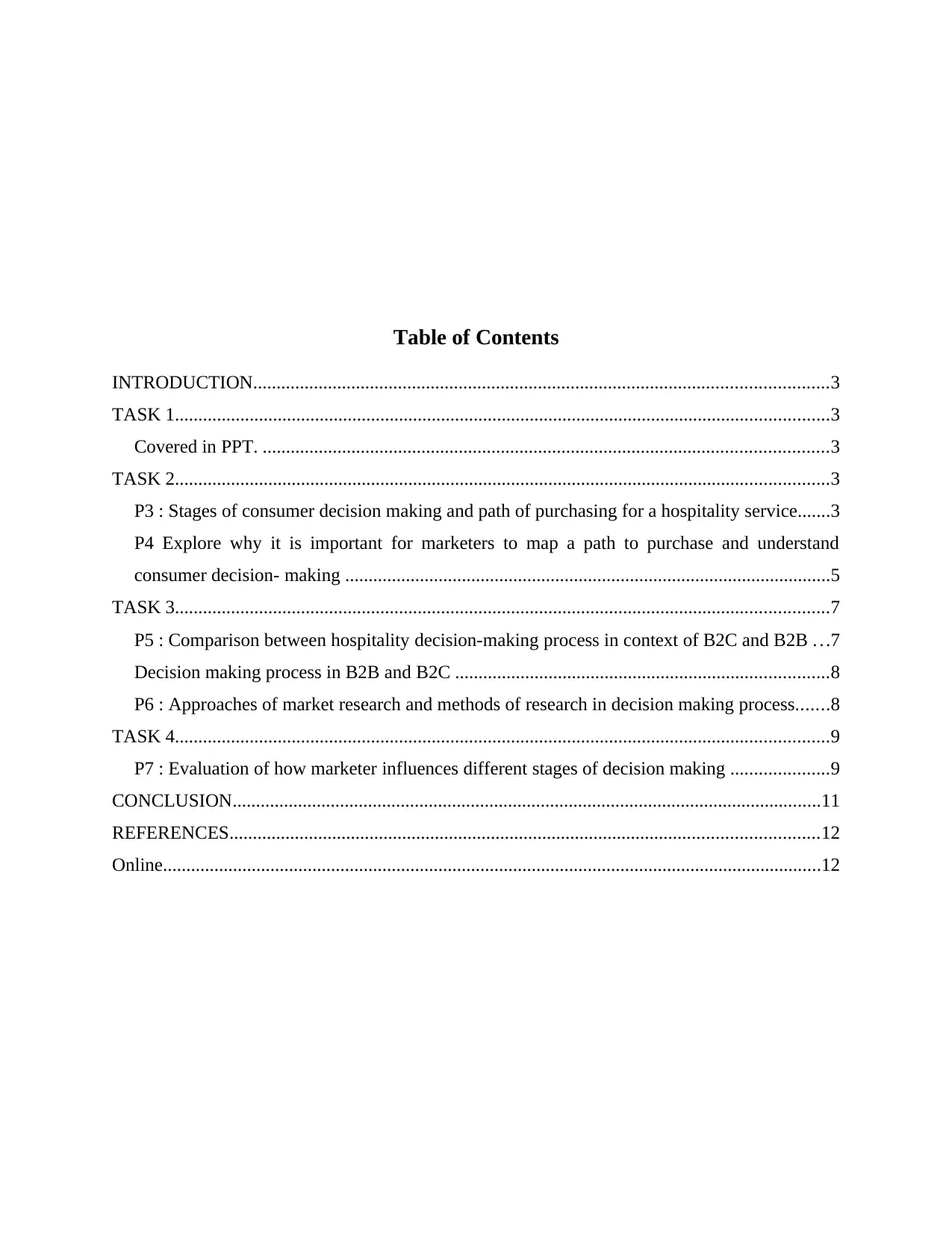
Table of Contents
INTRODUCTION...........................................................................................................................3
TASK 1............................................................................................................................................3
Covered in PPT. .........................................................................................................................3
TASK 2............................................................................................................................................3
P3 : Stages of consumer decision making and path of purchasing for a hospitality service.......3
P4 Explore why it is important for marketers to map a path to purchase and understand
consumer decision- making ........................................................................................................5
TASK 3............................................................................................................................................7
P5 : Comparison between hospitality decision-making process in context of B2C and B2B . . .7
Decision making process in B2B and B2C ................................................................................8
P6 : Approaches of market research and methods of research in decision making process.......8
TASK 4............................................................................................................................................9
P7 : Evaluation of how marketer influences different stages of decision making .....................9
CONCLUSION..............................................................................................................................11
REFERENCES..............................................................................................................................12
Online.............................................................................................................................................12
INTRODUCTION...........................................................................................................................3
TASK 1............................................................................................................................................3
Covered in PPT. .........................................................................................................................3
TASK 2............................................................................................................................................3
P3 : Stages of consumer decision making and path of purchasing for a hospitality service.......3
P4 Explore why it is important for marketers to map a path to purchase and understand
consumer decision- making ........................................................................................................5
TASK 3............................................................................................................................................7
P5 : Comparison between hospitality decision-making process in context of B2C and B2B . . .7
Decision making process in B2B and B2C ................................................................................8
P6 : Approaches of market research and methods of research in decision making process.......8
TASK 4............................................................................................................................................9
P7 : Evaluation of how marketer influences different stages of decision making .....................9
CONCLUSION..............................................................................................................................11
REFERENCES..............................................................................................................................12
Online.............................................................................................................................................12
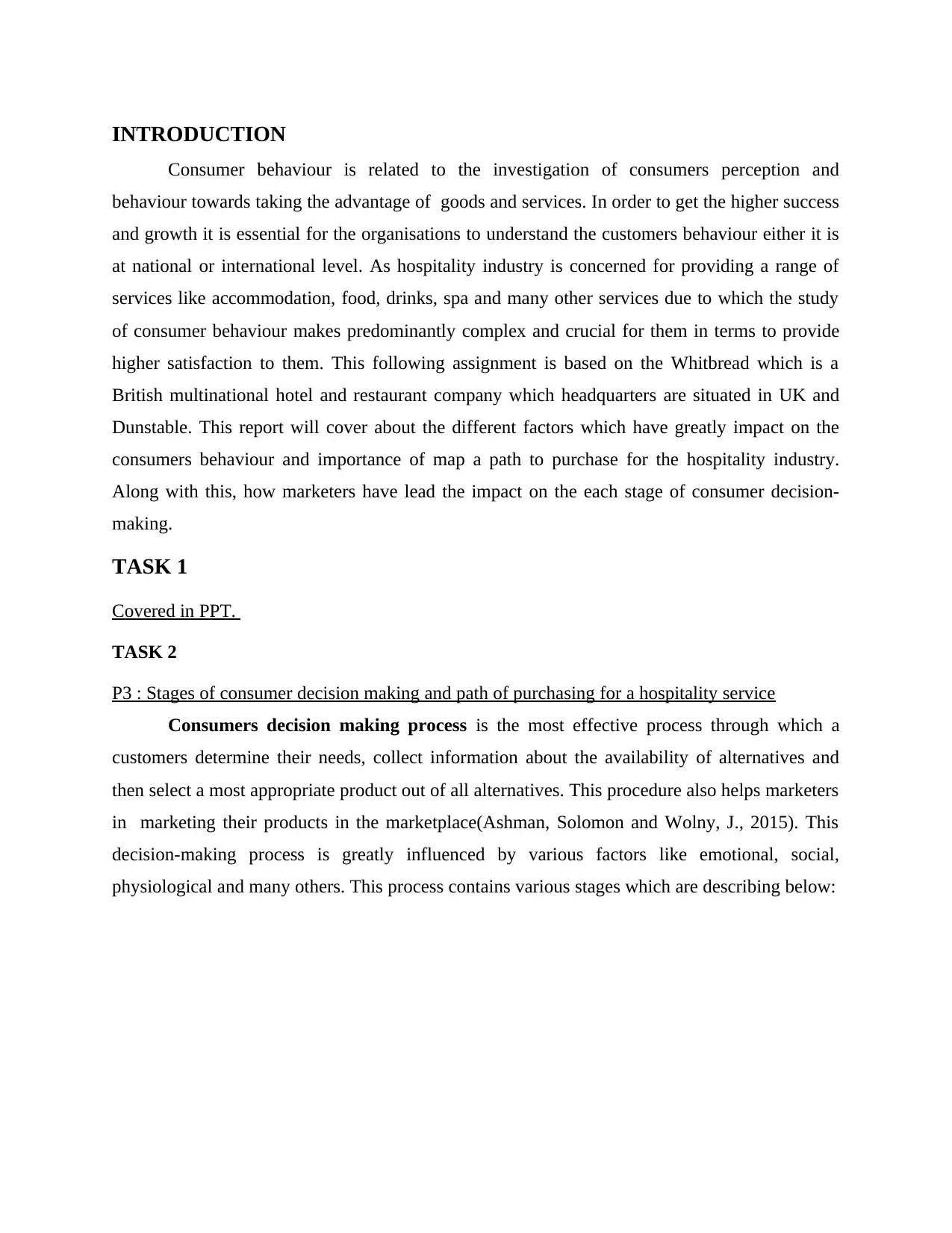
INTRODUCTION
Consumer behaviour is related to the investigation of consumers perception and
behaviour towards taking the advantage of goods and services. In order to get the higher success
and growth it is essential for the organisations to understand the customers behaviour either it is
at national or international level. As hospitality industry is concerned for providing a range of
services like accommodation, food, drinks, spa and many other services due to which the study
of consumer behaviour makes predominantly complex and crucial for them in terms to provide
higher satisfaction to them. This following assignment is based on the Whitbread which is a
British multinational hotel and restaurant company which headquarters are situated in UK and
Dunstable. This report will cover about the different factors which have greatly impact on the
consumers behaviour and importance of map a path to purchase for the hospitality industry.
Along with this, how marketers have lead the impact on the each stage of consumer decision-
making.
TASK 1
Covered in PPT.
TASK 2
P3 : Stages of consumer decision making and path of purchasing for a hospitality service
Consumers decision making process is the most effective process through which a
customers determine their needs, collect information about the availability of alternatives and
then select a most appropriate product out of all alternatives. This procedure also helps marketers
in marketing their products in the marketplace(Ashman, Solomon and Wolny, J., 2015). This
decision-making process is greatly influenced by various factors like emotional, social,
physiological and many others. This process contains various stages which are describing below:
Consumer behaviour is related to the investigation of consumers perception and
behaviour towards taking the advantage of goods and services. In order to get the higher success
and growth it is essential for the organisations to understand the customers behaviour either it is
at national or international level. As hospitality industry is concerned for providing a range of
services like accommodation, food, drinks, spa and many other services due to which the study
of consumer behaviour makes predominantly complex and crucial for them in terms to provide
higher satisfaction to them. This following assignment is based on the Whitbread which is a
British multinational hotel and restaurant company which headquarters are situated in UK and
Dunstable. This report will cover about the different factors which have greatly impact on the
consumers behaviour and importance of map a path to purchase for the hospitality industry.
Along with this, how marketers have lead the impact on the each stage of consumer decision-
making.
TASK 1
Covered in PPT.
TASK 2
P3 : Stages of consumer decision making and path of purchasing for a hospitality service
Consumers decision making process is the most effective process through which a
customers determine their needs, collect information about the availability of alternatives and
then select a most appropriate product out of all alternatives. This procedure also helps marketers
in marketing their products in the marketplace(Ashman, Solomon and Wolny, J., 2015). This
decision-making process is greatly influenced by various factors like emotional, social,
physiological and many others. This process contains various stages which are describing below:
⊘ This is a preview!⊘
Do you want full access?
Subscribe today to unlock all pages.

Trusted by 1+ million students worldwide
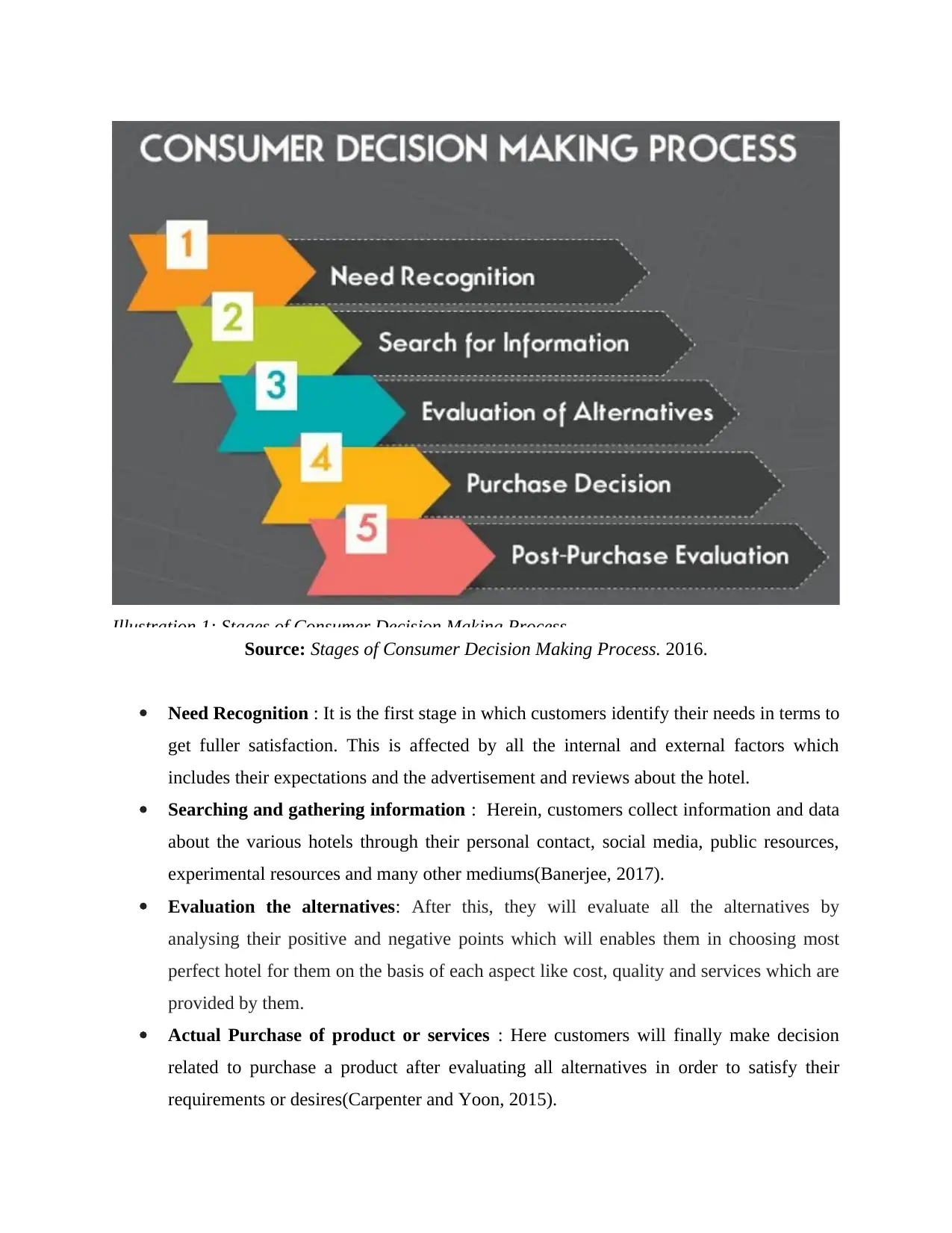
Illustration 1: Stages of Consumer Decision Making Process
Source: Stages of Consumer Decision Making Process. 2016.
Need Recognition : It is the first stage in which customers identify their needs in terms to
get fuller satisfaction. This is affected by all the internal and external factors which
includes their expectations and the advertisement and reviews about the hotel.
Searching and gathering information : Herein, customers collect information and data
about the various hotels through their personal contact, social media, public resources,
experimental resources and many other mediums(Banerjee, 2017).
Evaluation the alternatives: After this, they will evaluate all the alternatives by
analysing their positive and negative points which will enables them in choosing most
perfect hotel for them on the basis of each aspect like cost, quality and services which are
provided by them.
Actual Purchase of product or services : Here customers will finally make decision
related to purchase a product after evaluating all alternatives in order to satisfy their
requirements or desires(Carpenter and Yoon, 2015).
Source: Stages of Consumer Decision Making Process. 2016.
Need Recognition : It is the first stage in which customers identify their needs in terms to
get fuller satisfaction. This is affected by all the internal and external factors which
includes their expectations and the advertisement and reviews about the hotel.
Searching and gathering information : Herein, customers collect information and data
about the various hotels through their personal contact, social media, public resources,
experimental resources and many other mediums(Banerjee, 2017).
Evaluation the alternatives: After this, they will evaluate all the alternatives by
analysing their positive and negative points which will enables them in choosing most
perfect hotel for them on the basis of each aspect like cost, quality and services which are
provided by them.
Actual Purchase of product or services : Here customers will finally make decision
related to purchase a product after evaluating all alternatives in order to satisfy their
requirements or desires(Carpenter and Yoon, 2015).
Paraphrase This Document
Need a fresh take? Get an instant paraphrase of this document with our AI Paraphraser
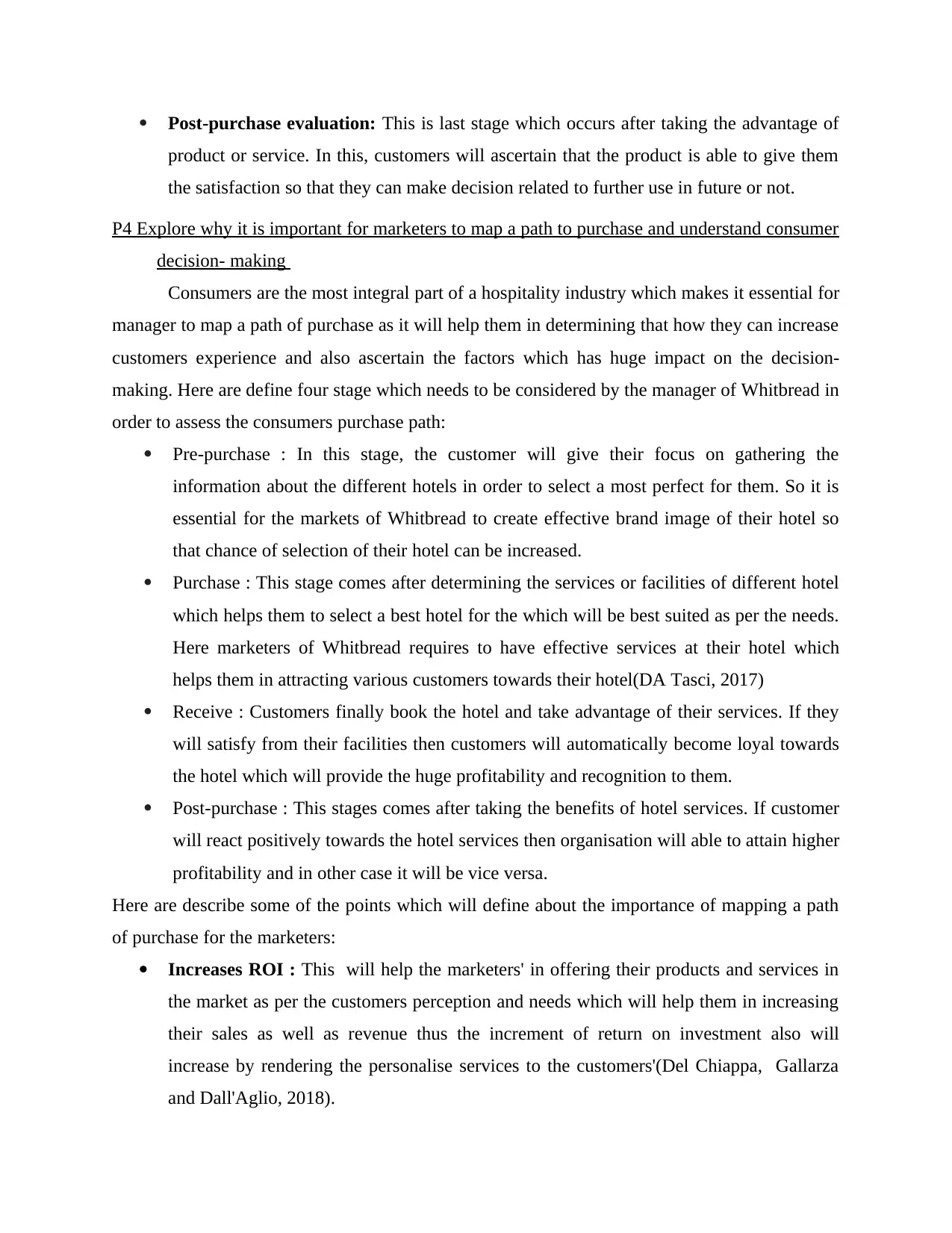
Post-purchase evaluation: This is last stage which occurs after taking the advantage of
product or service. In this, customers will ascertain that the product is able to give them
the satisfaction so that they can make decision related to further use in future or not.
P4 Explore why it is important for marketers to map a path to purchase and understand consumer
decision- making
Consumers are the most integral part of a hospitality industry which makes it essential for
manager to map a path of purchase as it will help them in determining that how they can increase
customers experience and also ascertain the factors which has huge impact on the decision-
making. Here are define four stage which needs to be considered by the manager of Whitbread in
order to assess the consumers purchase path:
Pre-purchase : In this stage, the customer will give their focus on gathering the
information about the different hotels in order to select a most perfect for them. So it is
essential for the markets of Whitbread to create effective brand image of their hotel so
that chance of selection of their hotel can be increased.
Purchase : This stage comes after determining the services or facilities of different hotel
which helps them to select a best hotel for the which will be best suited as per the needs.
Here marketers of Whitbread requires to have effective services at their hotel which
helps them in attracting various customers towards their hotel(DA Tasci, 2017)
Receive : Customers finally book the hotel and take advantage of their services. If they
will satisfy from their facilities then customers will automatically become loyal towards
the hotel which will provide the huge profitability and recognition to them.
Post-purchase : This stages comes after taking the benefits of hotel services. If customer
will react positively towards the hotel services then organisation will able to attain higher
profitability and in other case it will be vice versa.
Here are describe some of the points which will define about the importance of mapping a path
of purchase for the marketers:
Increases ROI : This will help the marketers' in offering their products and services in
the market as per the customers perception and needs which will help them in increasing
their sales as well as revenue thus the increment of return on investment also will
increase by rendering the personalise services to the customers'(Del Chiappa, Gallarza
and Dall'Aglio, 2018).
product or service. In this, customers will ascertain that the product is able to give them
the satisfaction so that they can make decision related to further use in future or not.
P4 Explore why it is important for marketers to map a path to purchase and understand consumer
decision- making
Consumers are the most integral part of a hospitality industry which makes it essential for
manager to map a path of purchase as it will help them in determining that how they can increase
customers experience and also ascertain the factors which has huge impact on the decision-
making. Here are define four stage which needs to be considered by the manager of Whitbread in
order to assess the consumers purchase path:
Pre-purchase : In this stage, the customer will give their focus on gathering the
information about the different hotels in order to select a most perfect for them. So it is
essential for the markets of Whitbread to create effective brand image of their hotel so
that chance of selection of their hotel can be increased.
Purchase : This stage comes after determining the services or facilities of different hotel
which helps them to select a best hotel for the which will be best suited as per the needs.
Here marketers of Whitbread requires to have effective services at their hotel which
helps them in attracting various customers towards their hotel(DA Tasci, 2017)
Receive : Customers finally book the hotel and take advantage of their services. If they
will satisfy from their facilities then customers will automatically become loyal towards
the hotel which will provide the huge profitability and recognition to them.
Post-purchase : This stages comes after taking the benefits of hotel services. If customer
will react positively towards the hotel services then organisation will able to attain higher
profitability and in other case it will be vice versa.
Here are describe some of the points which will define about the importance of mapping a path
of purchase for the marketers:
Increases ROI : This will help the marketers' in offering their products and services in
the market as per the customers perception and needs which will help them in increasing
their sales as well as revenue thus the increment of return on investment also will
increase by rendering the personalise services to the customers'(Del Chiappa, Gallarza
and Dall'Aglio, 2018).
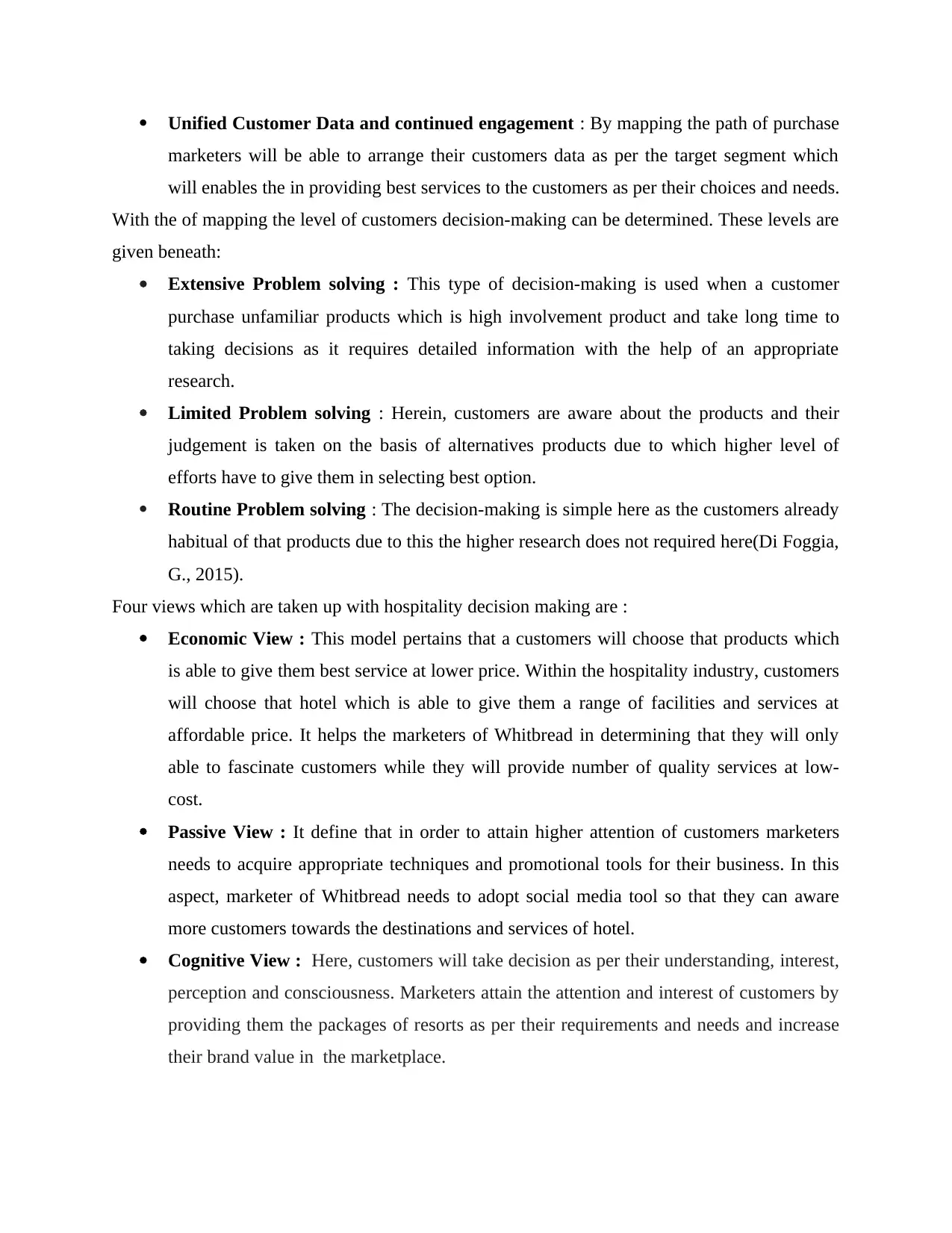
Unified Customer Data and continued engagement : By mapping the path of purchase
marketers will be able to arrange their customers data as per the target segment which
will enables the in providing best services to the customers as per their choices and needs.
With the of mapping the level of customers decision-making can be determined. These levels are
given beneath:
Extensive Problem solving : This type of decision-making is used when a customer
purchase unfamiliar products which is high involvement product and take long time to
taking decisions as it requires detailed information with the help of an appropriate
research.
Limited Problem solving : Herein, customers are aware about the products and their
judgement is taken on the basis of alternatives products due to which higher level of
efforts have to give them in selecting best option.
Routine Problem solving : The decision-making is simple here as the customers already
habitual of that products due to this the higher research does not required here(Di Foggia,
G., 2015).
Four views which are taken up with hospitality decision making are :
Economic View : This model pertains that a customers will choose that products which
is able to give them best service at lower price. Within the hospitality industry, customers
will choose that hotel which is able to give them a range of facilities and services at
affordable price. It helps the marketers of Whitbread in determining that they will only
able to fascinate customers while they will provide number of quality services at low-
cost.
Passive View : It define that in order to attain higher attention of customers marketers
needs to acquire appropriate techniques and promotional tools for their business. In this
aspect, marketer of Whitbread needs to adopt social media tool so that they can aware
more customers towards the destinations and services of hotel.
Cognitive View : Here, customers will take decision as per their understanding, interest,
perception and consciousness. Marketers attain the attention and interest of customers by
providing them the packages of resorts as per their requirements and needs and increase
their brand value in the marketplace.
marketers will be able to arrange their customers data as per the target segment which
will enables the in providing best services to the customers as per their choices and needs.
With the of mapping the level of customers decision-making can be determined. These levels are
given beneath:
Extensive Problem solving : This type of decision-making is used when a customer
purchase unfamiliar products which is high involvement product and take long time to
taking decisions as it requires detailed information with the help of an appropriate
research.
Limited Problem solving : Herein, customers are aware about the products and their
judgement is taken on the basis of alternatives products due to which higher level of
efforts have to give them in selecting best option.
Routine Problem solving : The decision-making is simple here as the customers already
habitual of that products due to this the higher research does not required here(Di Foggia,
G., 2015).
Four views which are taken up with hospitality decision making are :
Economic View : This model pertains that a customers will choose that products which
is able to give them best service at lower price. Within the hospitality industry, customers
will choose that hotel which is able to give them a range of facilities and services at
affordable price. It helps the marketers of Whitbread in determining that they will only
able to fascinate customers while they will provide number of quality services at low-
cost.
Passive View : It define that in order to attain higher attention of customers marketers
needs to acquire appropriate techniques and promotional tools for their business. In this
aspect, marketer of Whitbread needs to adopt social media tool so that they can aware
more customers towards the destinations and services of hotel.
Cognitive View : Here, customers will take decision as per their understanding, interest,
perception and consciousness. Marketers attain the attention and interest of customers by
providing them the packages of resorts as per their requirements and needs and increase
their brand value in the marketplace.
⊘ This is a preview!⊘
Do you want full access?
Subscribe today to unlock all pages.

Trusted by 1+ million students worldwide
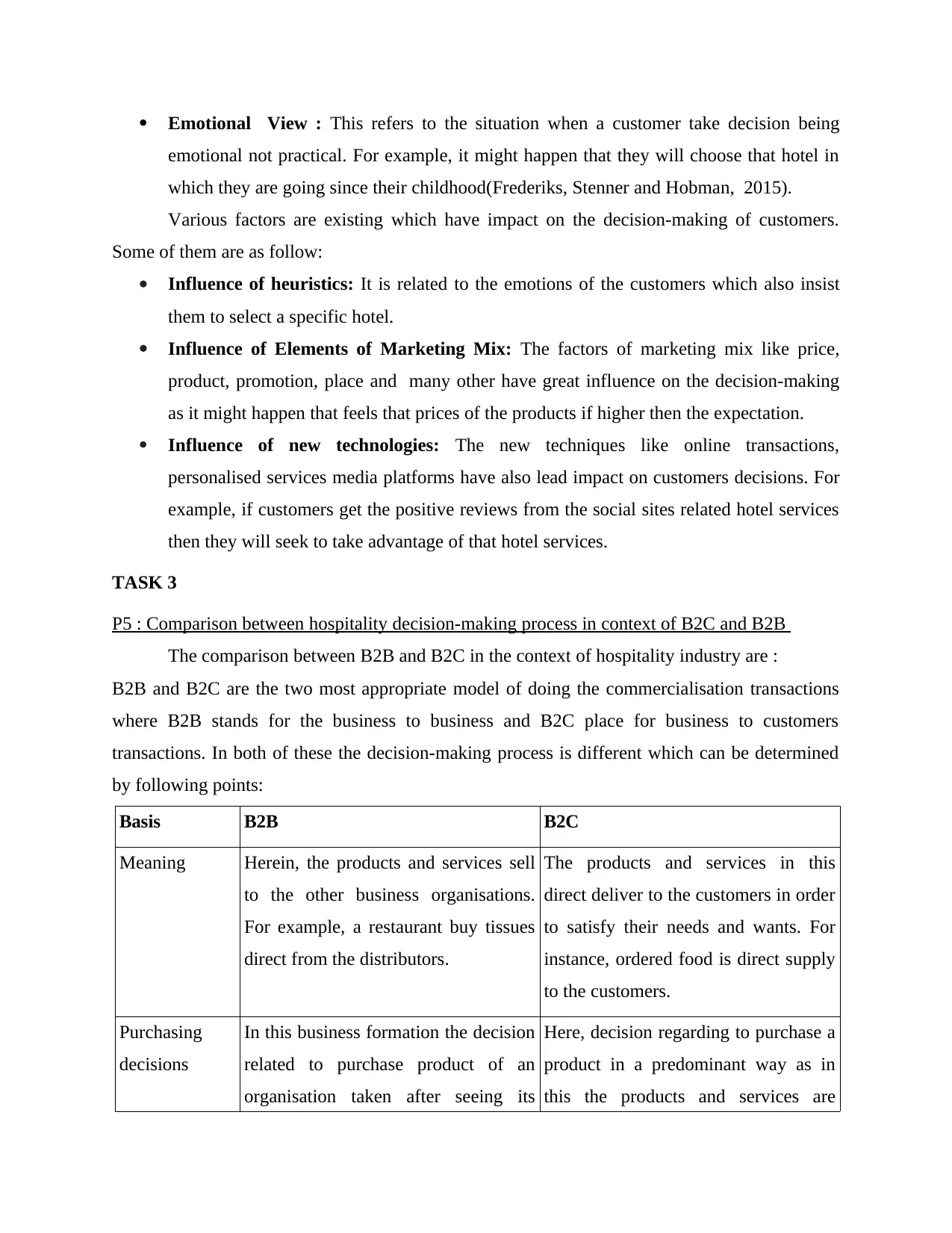
Emotional View : This refers to the situation when a customer take decision being
emotional not practical. For example, it might happen that they will choose that hotel in
which they are going since their childhood(Frederiks, Stenner and Hobman, 2015).
Various factors are existing which have impact on the decision-making of customers.
Some of them are as follow:
Influence of heuristics: It is related to the emotions of the customers which also insist
them to select a specific hotel.
Influence of Elements of Marketing Mix: The factors of marketing mix like price,
product, promotion, place and many other have great influence on the decision-making
as it might happen that feels that prices of the products if higher then the expectation.
Influence of new technologies: The new techniques like online transactions,
personalised services media platforms have also lead impact on customers decisions. For
example, if customers get the positive reviews from the social sites related hotel services
then they will seek to take advantage of that hotel services.
TASK 3
P5 : Comparison between hospitality decision-making process in context of B2C and B2B
The comparison between B2B and B2C in the context of hospitality industry are :
B2B and B2C are the two most appropriate model of doing the commercialisation transactions
where B2B stands for the business to business and B2C place for business to customers
transactions. In both of these the decision-making process is different which can be determined
by following points:
Basis B2B B2C
Meaning Herein, the products and services sell
to the other business organisations.
For example, a restaurant buy tissues
direct from the distributors.
The products and services in this
direct deliver to the customers in order
to satisfy their needs and wants. For
instance, ordered food is direct supply
to the customers.
Purchasing
decisions
In this business formation the decision
related to purchase product of an
organisation taken after seeing its
Here, decision regarding to purchase a
product in a predominant way as in
this the products and services are
emotional not practical. For example, it might happen that they will choose that hotel in
which they are going since their childhood(Frederiks, Stenner and Hobman, 2015).
Various factors are existing which have impact on the decision-making of customers.
Some of them are as follow:
Influence of heuristics: It is related to the emotions of the customers which also insist
them to select a specific hotel.
Influence of Elements of Marketing Mix: The factors of marketing mix like price,
product, promotion, place and many other have great influence on the decision-making
as it might happen that feels that prices of the products if higher then the expectation.
Influence of new technologies: The new techniques like online transactions,
personalised services media platforms have also lead impact on customers decisions. For
example, if customers get the positive reviews from the social sites related hotel services
then they will seek to take advantage of that hotel services.
TASK 3
P5 : Comparison between hospitality decision-making process in context of B2C and B2B
The comparison between B2B and B2C in the context of hospitality industry are :
B2B and B2C are the two most appropriate model of doing the commercialisation transactions
where B2B stands for the business to business and B2C place for business to customers
transactions. In both of these the decision-making process is different which can be determined
by following points:
Basis B2B B2C
Meaning Herein, the products and services sell
to the other business organisations.
For example, a restaurant buy tissues
direct from the distributors.
The products and services in this
direct deliver to the customers in order
to satisfy their needs and wants. For
instance, ordered food is direct supply
to the customers.
Purchasing
decisions
In this business formation the decision
related to purchase product of an
organisation taken after seeing its
Here, decision regarding to purchase a
product in a predominant way as in
this the products and services are
Paraphrase This Document
Need a fresh take? Get an instant paraphrase of this document with our AI Paraphraser
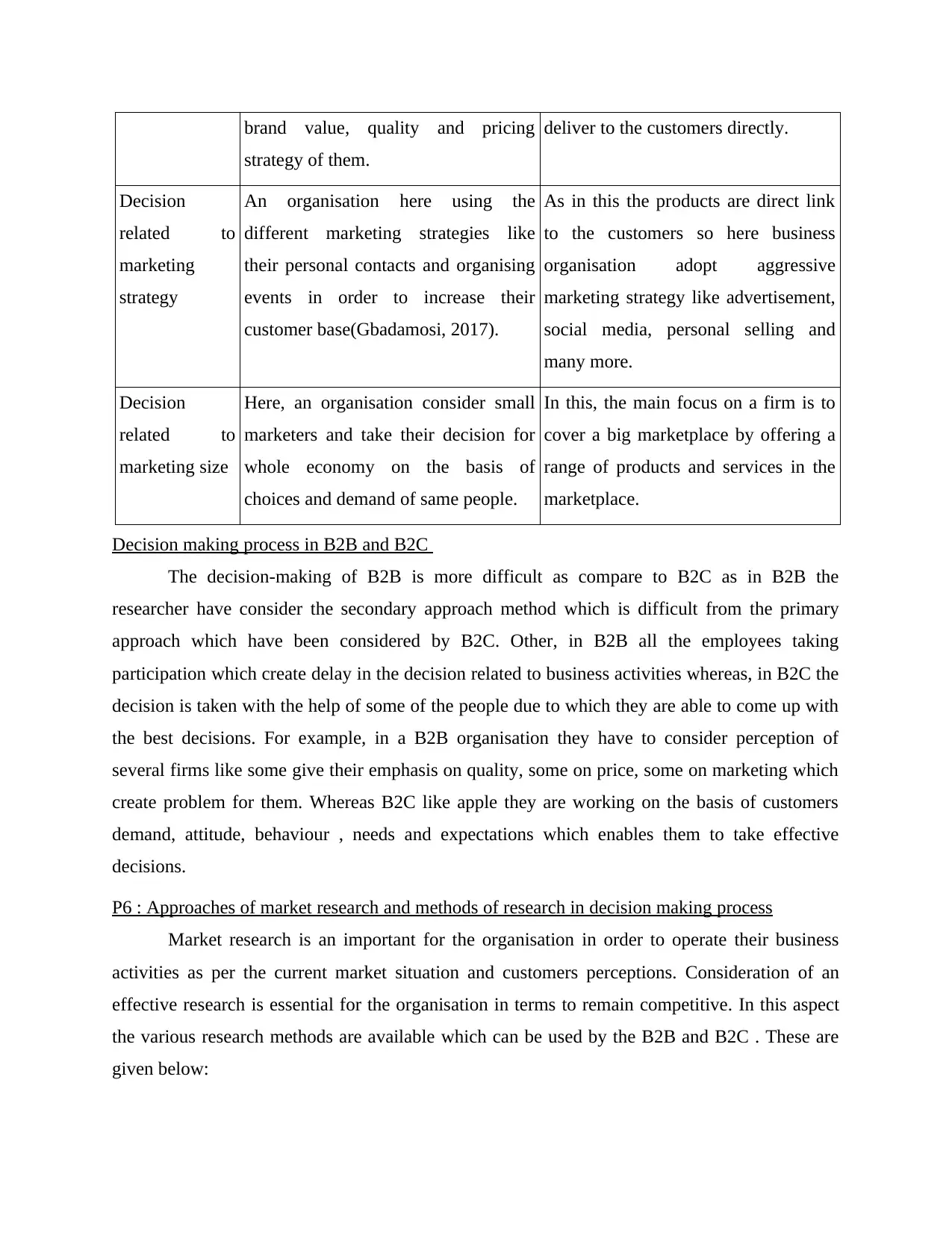
brand value, quality and pricing
strategy of them.
deliver to the customers directly.
Decision
related to
marketing
strategy
An organisation here using the
different marketing strategies like
their personal contacts and organising
events in order to increase their
customer base(Gbadamosi, 2017).
As in this the products are direct link
to the customers so here business
organisation adopt aggressive
marketing strategy like advertisement,
social media, personal selling and
many more.
Decision
related to
marketing size
Here, an organisation consider small
marketers and take their decision for
whole economy on the basis of
choices and demand of same people.
In this, the main focus on a firm is to
cover a big marketplace by offering a
range of products and services in the
marketplace.
Decision making process in B2B and B2C
The decision-making of B2B is more difficult as compare to B2C as in B2B the
researcher have consider the secondary approach method which is difficult from the primary
approach which have been considered by B2C. Other, in B2B all the employees taking
participation which create delay in the decision related to business activities whereas, in B2C the
decision is taken with the help of some of the people due to which they are able to come up with
the best decisions. For example, in a B2B organisation they have to consider perception of
several firms like some give their emphasis on quality, some on price, some on marketing which
create problem for them. Whereas B2C like apple they are working on the basis of customers
demand, attitude, behaviour , needs and expectations which enables them to take effective
decisions.
P6 : Approaches of market research and methods of research in decision making process
Market research is an important for the organisation in order to operate their business
activities as per the current market situation and customers perceptions. Consideration of an
effective research is essential for the organisation in terms to remain competitive. In this aspect
the various research methods are available which can be used by the B2B and B2C . These are
given below:
strategy of them.
deliver to the customers directly.
Decision
related to
marketing
strategy
An organisation here using the
different marketing strategies like
their personal contacts and organising
events in order to increase their
customer base(Gbadamosi, 2017).
As in this the products are direct link
to the customers so here business
organisation adopt aggressive
marketing strategy like advertisement,
social media, personal selling and
many more.
Decision
related to
marketing size
Here, an organisation consider small
marketers and take their decision for
whole economy on the basis of
choices and demand of same people.
In this, the main focus on a firm is to
cover a big marketplace by offering a
range of products and services in the
marketplace.
Decision making process in B2B and B2C
The decision-making of B2B is more difficult as compare to B2C as in B2B the
researcher have consider the secondary approach method which is difficult from the primary
approach which have been considered by B2C. Other, in B2B all the employees taking
participation which create delay in the decision related to business activities whereas, in B2C the
decision is taken with the help of some of the people due to which they are able to come up with
the best decisions. For example, in a B2B organisation they have to consider perception of
several firms like some give their emphasis on quality, some on price, some on marketing which
create problem for them. Whereas B2C like apple they are working on the basis of customers
demand, attitude, behaviour , needs and expectations which enables them to take effective
decisions.
P6 : Approaches of market research and methods of research in decision making process
Market research is an important for the organisation in order to operate their business
activities as per the current market situation and customers perceptions. Consideration of an
effective research is essential for the organisation in terms to remain competitive. In this aspect
the various research methods are available which can be used by the B2B and B2C . These are
given below:
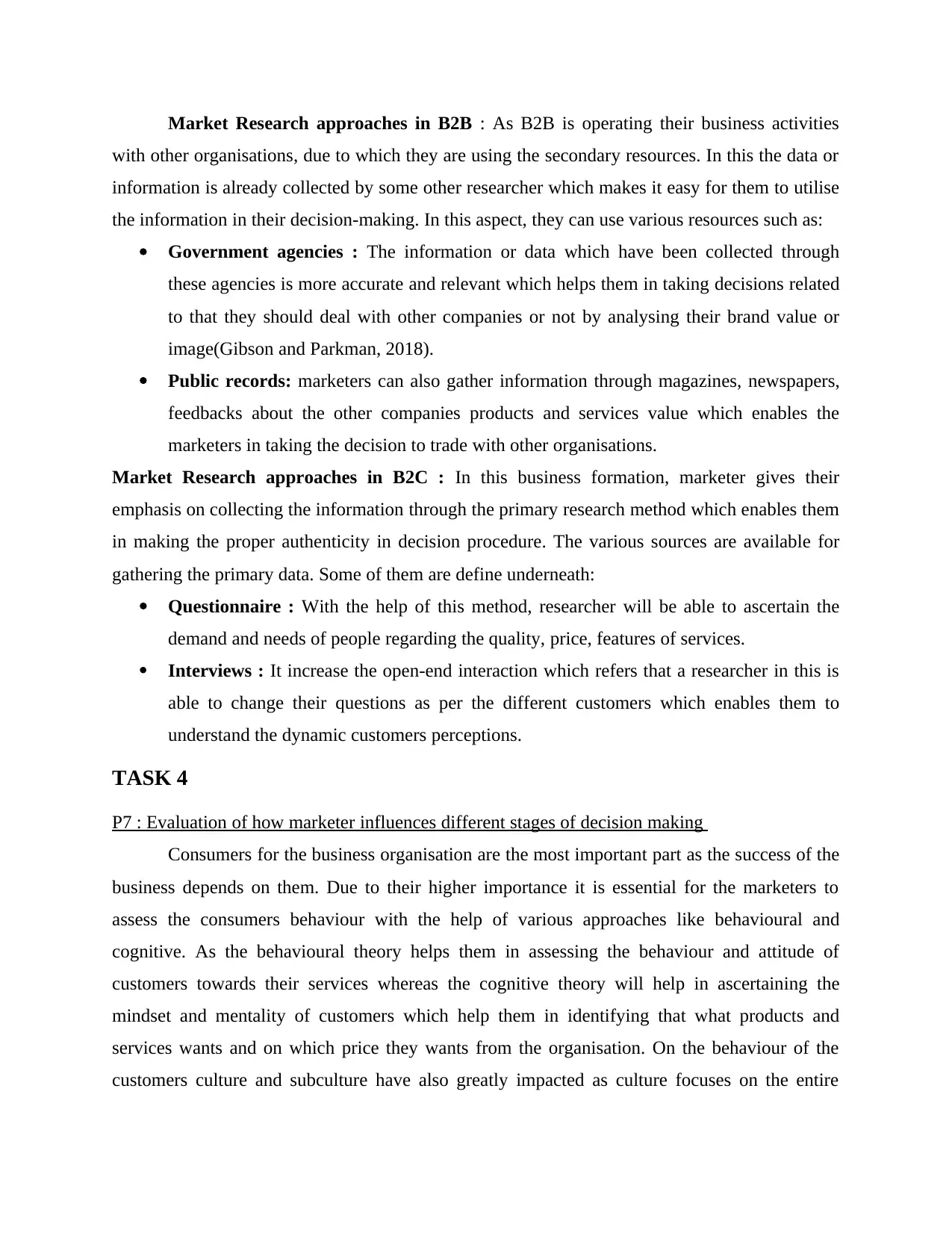
Market Research approaches in B2B : As B2B is operating their business activities
with other organisations, due to which they are using the secondary resources. In this the data or
information is already collected by some other researcher which makes it easy for them to utilise
the information in their decision-making. In this aspect, they can use various resources such as:
Government agencies : The information or data which have been collected through
these agencies is more accurate and relevant which helps them in taking decisions related
to that they should deal with other companies or not by analysing their brand value or
image(Gibson and Parkman, 2018).
Public records: marketers can also gather information through magazines, newspapers,
feedbacks about the other companies products and services value which enables the
marketers in taking the decision to trade with other organisations.
Market Research approaches in B2C : In this business formation, marketer gives their
emphasis on collecting the information through the primary research method which enables them
in making the proper authenticity in decision procedure. The various sources are available for
gathering the primary data. Some of them are define underneath:
Questionnaire : With the help of this method, researcher will be able to ascertain the
demand and needs of people regarding the quality, price, features of services.
Interviews : It increase the open-end interaction which refers that a researcher in this is
able to change their questions as per the different customers which enables them to
understand the dynamic customers perceptions.
TASK 4
P7 : Evaluation of how marketer influences different stages of decision making
Consumers for the business organisation are the most important part as the success of the
business depends on them. Due to their higher importance it is essential for the marketers to
assess the consumers behaviour with the help of various approaches like behavioural and
cognitive. As the behavioural theory helps them in assessing the behaviour and attitude of
customers towards their services whereas the cognitive theory will help in ascertaining the
mindset and mentality of customers which help them in identifying that what products and
services wants and on which price they wants from the organisation. On the behaviour of the
customers culture and subculture have also greatly impacted as culture focuses on the entire
with other organisations, due to which they are using the secondary resources. In this the data or
information is already collected by some other researcher which makes it easy for them to utilise
the information in their decision-making. In this aspect, they can use various resources such as:
Government agencies : The information or data which have been collected through
these agencies is more accurate and relevant which helps them in taking decisions related
to that they should deal with other companies or not by analysing their brand value or
image(Gibson and Parkman, 2018).
Public records: marketers can also gather information through magazines, newspapers,
feedbacks about the other companies products and services value which enables the
marketers in taking the decision to trade with other organisations.
Market Research approaches in B2C : In this business formation, marketer gives their
emphasis on collecting the information through the primary research method which enables them
in making the proper authenticity in decision procedure. The various sources are available for
gathering the primary data. Some of them are define underneath:
Questionnaire : With the help of this method, researcher will be able to ascertain the
demand and needs of people regarding the quality, price, features of services.
Interviews : It increase the open-end interaction which refers that a researcher in this is
able to change their questions as per the different customers which enables them to
understand the dynamic customers perceptions.
TASK 4
P7 : Evaluation of how marketer influences different stages of decision making
Consumers for the business organisation are the most important part as the success of the
business depends on them. Due to their higher importance it is essential for the marketers to
assess the consumers behaviour with the help of various approaches like behavioural and
cognitive. As the behavioural theory helps them in assessing the behaviour and attitude of
customers towards their services whereas the cognitive theory will help in ascertaining the
mindset and mentality of customers which help them in identifying that what products and
services wants and on which price they wants from the organisation. On the behaviour of the
customers culture and subculture have also greatly impacted as culture focuses on the entire
⊘ This is a preview!⊘
Do you want full access?
Subscribe today to unlock all pages.

Trusted by 1+ million students worldwide
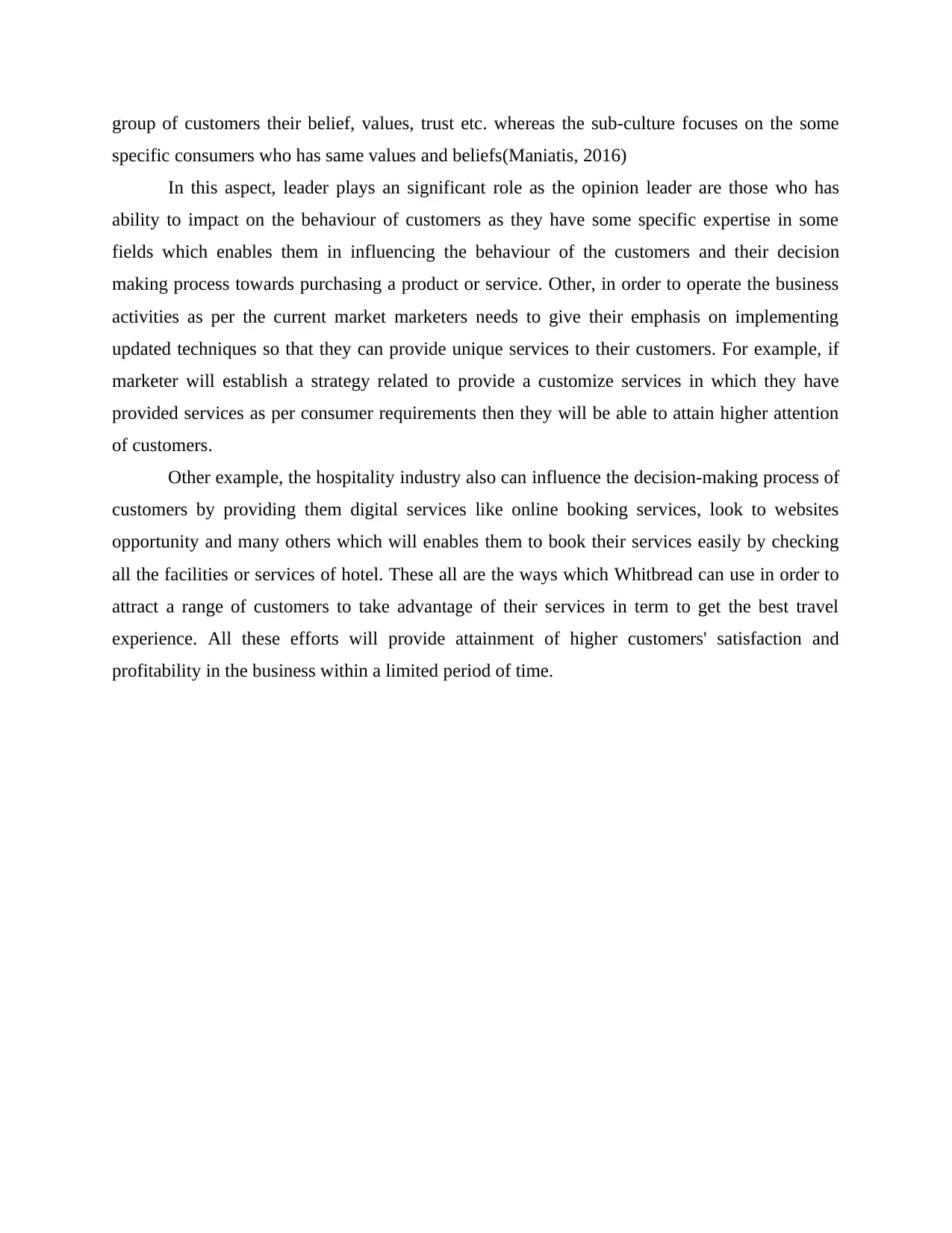
group of customers their belief, values, trust etc. whereas the sub-culture focuses on the some
specific consumers who has same values and beliefs(Maniatis, 2016)
In this aspect, leader plays an significant role as the opinion leader are those who has
ability to impact on the behaviour of customers as they have some specific expertise in some
fields which enables them in influencing the behaviour of the customers and their decision
making process towards purchasing a product or service. Other, in order to operate the business
activities as per the current market marketers needs to give their emphasis on implementing
updated techniques so that they can provide unique services to their customers. For example, if
marketer will establish a strategy related to provide a customize services in which they have
provided services as per consumer requirements then they will be able to attain higher attention
of customers.
Other example, the hospitality industry also can influence the decision-making process of
customers by providing them digital services like online booking services, look to websites
opportunity and many others which will enables them to book their services easily by checking
all the facilities or services of hotel. These all are the ways which Whitbread can use in order to
attract a range of customers to take advantage of their services in term to get the best travel
experience. All these efforts will provide attainment of higher customers' satisfaction and
profitability in the business within a limited period of time.
specific consumers who has same values and beliefs(Maniatis, 2016)
In this aspect, leader plays an significant role as the opinion leader are those who has
ability to impact on the behaviour of customers as they have some specific expertise in some
fields which enables them in influencing the behaviour of the customers and their decision
making process towards purchasing a product or service. Other, in order to operate the business
activities as per the current market marketers needs to give their emphasis on implementing
updated techniques so that they can provide unique services to their customers. For example, if
marketer will establish a strategy related to provide a customize services in which they have
provided services as per consumer requirements then they will be able to attain higher attention
of customers.
Other example, the hospitality industry also can influence the decision-making process of
customers by providing them digital services like online booking services, look to websites
opportunity and many others which will enables them to book their services easily by checking
all the facilities or services of hotel. These all are the ways which Whitbread can use in order to
attract a range of customers to take advantage of their services in term to get the best travel
experience. All these efforts will provide attainment of higher customers' satisfaction and
profitability in the business within a limited period of time.
Paraphrase This Document
Need a fresh take? Get an instant paraphrase of this document with our AI Paraphraser
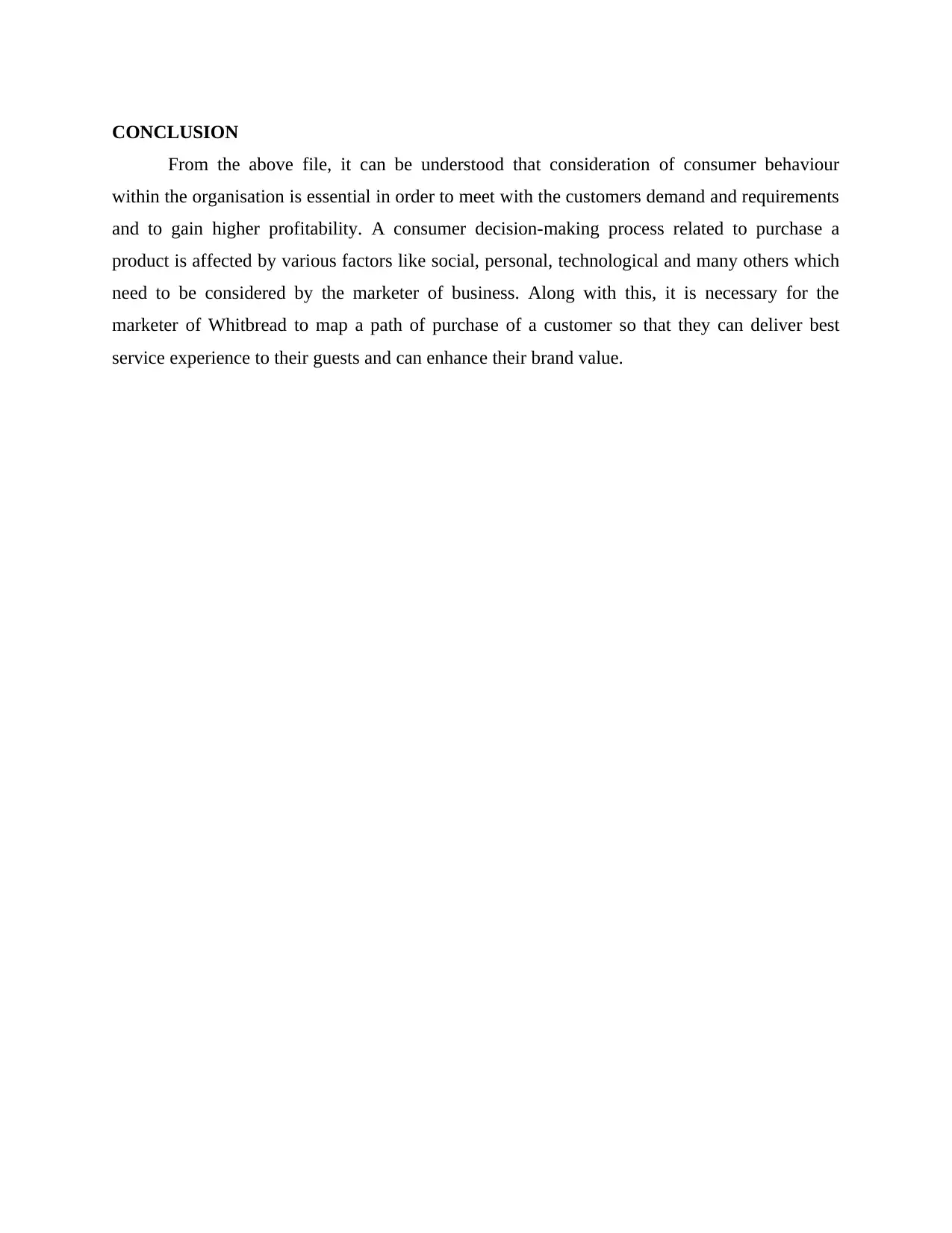
CONCLUSION
From the above file, it can be understood that consideration of consumer behaviour
within the organisation is essential in order to meet with the customers demand and requirements
and to gain higher profitability. A consumer decision-making process related to purchase a
product is affected by various factors like social, personal, technological and many others which
need to be considered by the marketer of business. Along with this, it is necessary for the
marketer of Whitbread to map a path of purchase of a customer so that they can deliver best
service experience to their guests and can enhance their brand value.
From the above file, it can be understood that consideration of consumer behaviour
within the organisation is essential in order to meet with the customers demand and requirements
and to gain higher profitability. A consumer decision-making process related to purchase a
product is affected by various factors like social, personal, technological and many others which
need to be considered by the marketer of business. Along with this, it is necessary for the
marketer of Whitbread to map a path of purchase of a customer so that they can deliver best
service experience to their guests and can enhance their brand value.
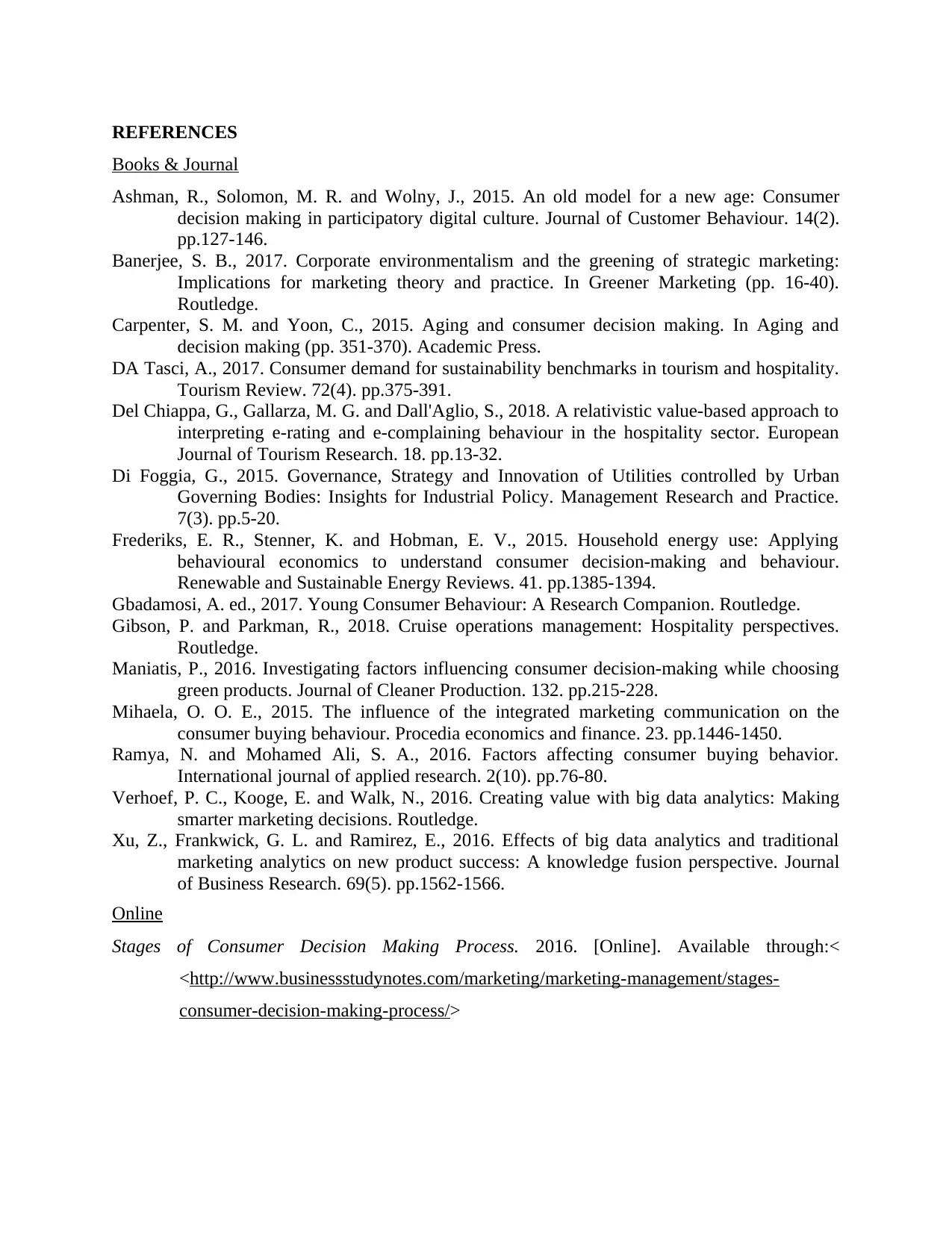
REFERENCES
Books & Journal
Ashman, R., Solomon, M. R. and Wolny, J., 2015. An old model for a new age: Consumer
decision making in participatory digital culture. Journal of Customer Behaviour. 14(2).
pp.127-146.
Banerjee, S. B., 2017. Corporate environmentalism and the greening of strategic marketing:
Implications for marketing theory and practice. In Greener Marketing (pp. 16-40).
Routledge.
Carpenter, S. M. and Yoon, C., 2015. Aging and consumer decision making. In Aging and
decision making (pp. 351-370). Academic Press.
DA Tasci, A., 2017. Consumer demand for sustainability benchmarks in tourism and hospitality.
Tourism Review. 72(4). pp.375-391.
Del Chiappa, G., Gallarza, M. G. and Dall'Aglio, S., 2018. A relativistic value-based approach to
interpreting e-rating and e-complaining behaviour in the hospitality sector. European
Journal of Tourism Research. 18. pp.13-32.
Di Foggia, G., 2015. Governance, Strategy and Innovation of Utilities controlled by Urban
Governing Bodies: Insights for Industrial Policy. Management Research and Practice.
7(3). pp.5-20.
Frederiks, E. R., Stenner, K. and Hobman, E. V., 2015. Household energy use: Applying
behavioural economics to understand consumer decision-making and behaviour.
Renewable and Sustainable Energy Reviews. 41. pp.1385-1394.
Gbadamosi, A. ed., 2017. Young Consumer Behaviour: A Research Companion. Routledge.
Gibson, P. and Parkman, R., 2018. Cruise operations management: Hospitality perspectives.
Routledge.
Maniatis, P., 2016. Investigating factors influencing consumer decision-making while choosing
green products. Journal of Cleaner Production. 132. pp.215-228.
Mihaela, O. O. E., 2015. The influence of the integrated marketing communication on the
consumer buying behaviour. Procedia economics and finance. 23. pp.1446-1450.
Ramya, N. and Mohamed Ali, S. A., 2016. Factors affecting consumer buying behavior.
International journal of applied research. 2(10). pp.76-80.
Verhoef, P. C., Kooge, E. and Walk, N., 2016. Creating value with big data analytics: Making
smarter marketing decisions. Routledge.
Xu, Z., Frankwick, G. L. and Ramirez, E., 2016. Effects of big data analytics and traditional
marketing analytics on new product success: A knowledge fusion perspective. Journal
of Business Research. 69(5). pp.1562-1566.
Online
Stages of Consumer Decision Making Process. 2016. [Online]. Available through:<
<http://www.businessstudynotes.com/marketing/marketing-management/stages-
consumer-decision-making-process/>
Books & Journal
Ashman, R., Solomon, M. R. and Wolny, J., 2015. An old model for a new age: Consumer
decision making in participatory digital culture. Journal of Customer Behaviour. 14(2).
pp.127-146.
Banerjee, S. B., 2017. Corporate environmentalism and the greening of strategic marketing:
Implications for marketing theory and practice. In Greener Marketing (pp. 16-40).
Routledge.
Carpenter, S. M. and Yoon, C., 2015. Aging and consumer decision making. In Aging and
decision making (pp. 351-370). Academic Press.
DA Tasci, A., 2017. Consumer demand for sustainability benchmarks in tourism and hospitality.
Tourism Review. 72(4). pp.375-391.
Del Chiappa, G., Gallarza, M. G. and Dall'Aglio, S., 2018. A relativistic value-based approach to
interpreting e-rating and e-complaining behaviour in the hospitality sector. European
Journal of Tourism Research. 18. pp.13-32.
Di Foggia, G., 2015. Governance, Strategy and Innovation of Utilities controlled by Urban
Governing Bodies: Insights for Industrial Policy. Management Research and Practice.
7(3). pp.5-20.
Frederiks, E. R., Stenner, K. and Hobman, E. V., 2015. Household energy use: Applying
behavioural economics to understand consumer decision-making and behaviour.
Renewable and Sustainable Energy Reviews. 41. pp.1385-1394.
Gbadamosi, A. ed., 2017. Young Consumer Behaviour: A Research Companion. Routledge.
Gibson, P. and Parkman, R., 2018. Cruise operations management: Hospitality perspectives.
Routledge.
Maniatis, P., 2016. Investigating factors influencing consumer decision-making while choosing
green products. Journal of Cleaner Production. 132. pp.215-228.
Mihaela, O. O. E., 2015. The influence of the integrated marketing communication on the
consumer buying behaviour. Procedia economics and finance. 23. pp.1446-1450.
Ramya, N. and Mohamed Ali, S. A., 2016. Factors affecting consumer buying behavior.
International journal of applied research. 2(10). pp.76-80.
Verhoef, P. C., Kooge, E. and Walk, N., 2016. Creating value with big data analytics: Making
smarter marketing decisions. Routledge.
Xu, Z., Frankwick, G. L. and Ramirez, E., 2016. Effects of big data analytics and traditional
marketing analytics on new product success: A knowledge fusion perspective. Journal
of Business Research. 69(5). pp.1562-1566.
Online
Stages of Consumer Decision Making Process. 2016. [Online]. Available through:<
<http://www.businessstudynotes.com/marketing/marketing-management/stages-
consumer-decision-making-process/>
⊘ This is a preview!⊘
Do you want full access?
Subscribe today to unlock all pages.

Trusted by 1+ million students worldwide
1 out of 13
Related Documents
Your All-in-One AI-Powered Toolkit for Academic Success.
+13062052269
info@desklib.com
Available 24*7 on WhatsApp / Email
![[object Object]](/_next/static/media/star-bottom.7253800d.svg)
Unlock your academic potential
Copyright © 2020–2025 A2Z Services. All Rights Reserved. Developed and managed by ZUCOL.





